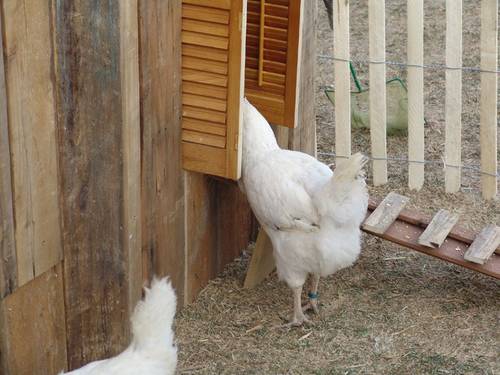
A Chicken Coop in Every Yard
Sustainable living and art collide in Boulder where a cooperative group of art students under the guidance of visiting Dutch and Slovenian artists designed the “Chicken Shack Village.” On September 26, the Boulder Museum of Contemporary Art hosted a panel discussion led by CU art students from the Baseline Group and local urban farmers. BMOCA is located on 13th Street in Boulder, in the heart of Boulders Farmers Market. Getting to the museum requires walking through booths of local organic produce, cheese, honey, meat, flowers and bread. Local musicians entertain while families and college students eat organic tamales and gyros served by food vendors. The farmers market is estimated to have an attendance of 360,000 per season and city restaurants have adopted the locavore movement, buying their foods locally. In Boulder, the focus on local and sustainable food production is at the forefront in the minds of most citizens. Its not surprising then that a group of art and architecture students would design the “Urban Chicken Coop Project”.

“Chicken Shack Village” The BASELINE GROUP with Haiko Meijer (University of Colorado, Boulder). Installation, Site Project.
Baseline Group is a class run by Professor Richard Saxton from the Art and Art History department at CU Boulder. The seminar is made up of graduate and undergraduate students in the processes of designing and implementing tangible large-scale projects. The class encourages students to develop work that is community-based and site-specific, using non-traditional media. This is the Baseline Groups first installation.
“Chicken Shack Village” came to be after community engagement and research. The students visited local farms, studied the history of the area, and participated in hands-on workshops with Marjetica Potrc, an artist from Ljubljana, Slovenia and Haiko Meijer, from the Dutch design team Onix. They used reclaimed lumber to build their chicken shacks and the installation on opening day included live chickens visiting from local farms. In conjunction, Architecture and Urban Planning professor Rob Pyatts design and build class completed a model for an easy-to-build chicken coop kit for homeowners, which is also on display.
The Baseline Group collective includes: Adrianna Santiago Pass, Alyssa Reese, Amber Cobb, Jennifer Bockelman, Jon Geiger, Max Bernstein, Marcy Saude, Nathaniel Jones, Patricia Lomas, Yolanda Chichester, and Ryan Schnirel.
Some audience members asked how building chicken coops is art-making?
Schnirel said that the process of gathering materials was arts making. It involved interactions.
But are the chicken coops works of art?
For the students, the answer is yes, because the process opened a dialogue. It made the students and hopefully the viewers more aware of from where our food is coming.
One student added: “It doesnt matter if its art, its the dialogue thats important. The art will follow.”

Chickens in the coop
Another said that it “parallels back to being aware of the local and of process. The shacks will live on in the community. They will live on and others will continue the process. The idea is of asking questions. Were not giving answers were trying to raise more questions.”
For the agricultural panelists: Anne P. Cure, Farm Manager from Cure Organic Farm; Dudley Dorrell, Tree Farm Natural Foods; Dallas Gilbert, Manager of the Eastern Plains Natural Co-op; Eille Goldberg and Jane McMahan, Boulder residents who raise chickens in their backyards the ideas are to find real sustainability.
Dorrell pointed out that in Colorado, sustainable is almost impossible because we cannot grow soybeans. The growing cycle for most gardens and farms is only a few months. Others on the panel concluded that buying locally is too simple and also doesnt work. The goal for many farmers is to create a diverse farm with a healthy ecosystem. And in cities throughout the West, regulations are being challenged and people are looking at raising honeybees and having chickens in their backyard.
“Big ag is going up in smoke,” Dorrell said. “A lot of people in world depend on cheap industrial food. The ecosystem has to be in balance in order to produce food naturally. More people are going to have to begin to grow their own food.”
And the panelists all agreed that starting with 2-3 chickens in the backyard is one of the easiest ways to move in the right direction. Poultry are year-round producers. Though they pointed out that after the first egg cycle, a chicken will molt and then after the second egg cycle, the cost of feeding the chicken is greater than the egg production. Thats the when the chicken can become a meal. Of course, those of us who live with foxes and coyotes and bears roaming wild in our backyards might find raising chickens a bit of a challenge.
But back to the art. Most of the shacks have regional vernacular: they are made with reclaimed barn wood; designed to look like mining shacks; and some have cow skulls attached and false western fronts. The students looked at the building materials as words. They looked at forms to create functional objects. A question they asked themselves is how are these not just coops but sculpture? In many ways they are exploring a current trend in contemporary art that questions the definitions of art and architecture. For these students, the two work with the same ideas and their goal is to create functional livable art.
But more importantly for these students, the chicken shack village is metaphor. Anyone can do it. Even an art student from ruburbia.
